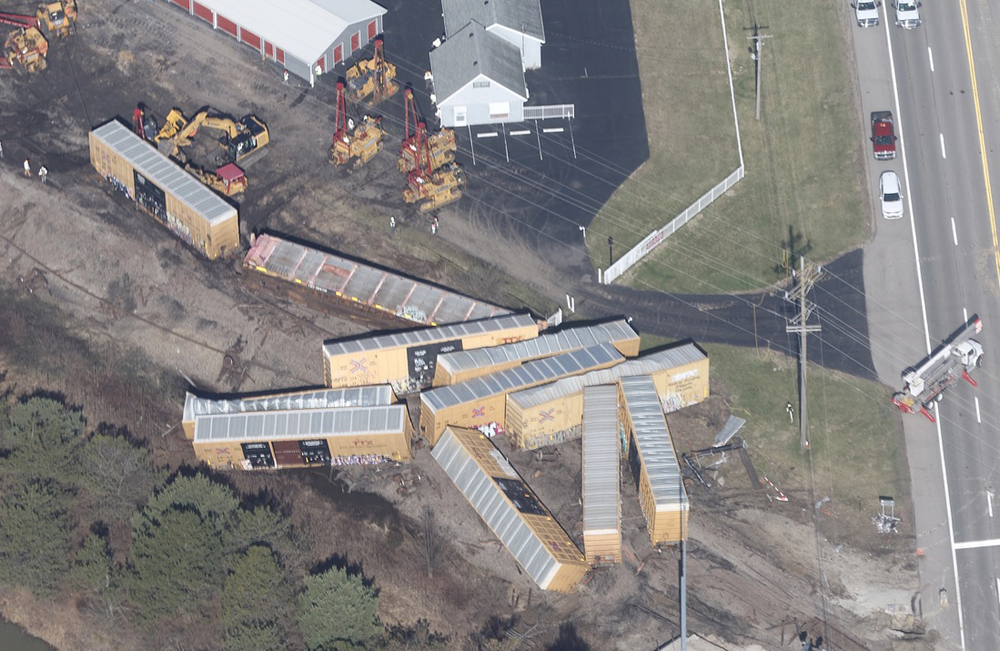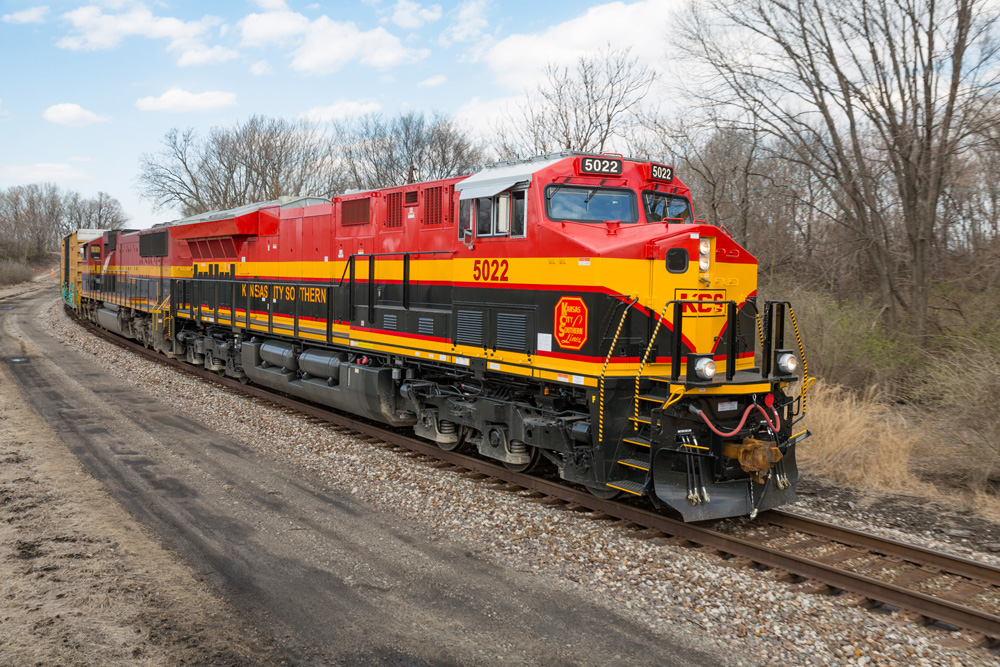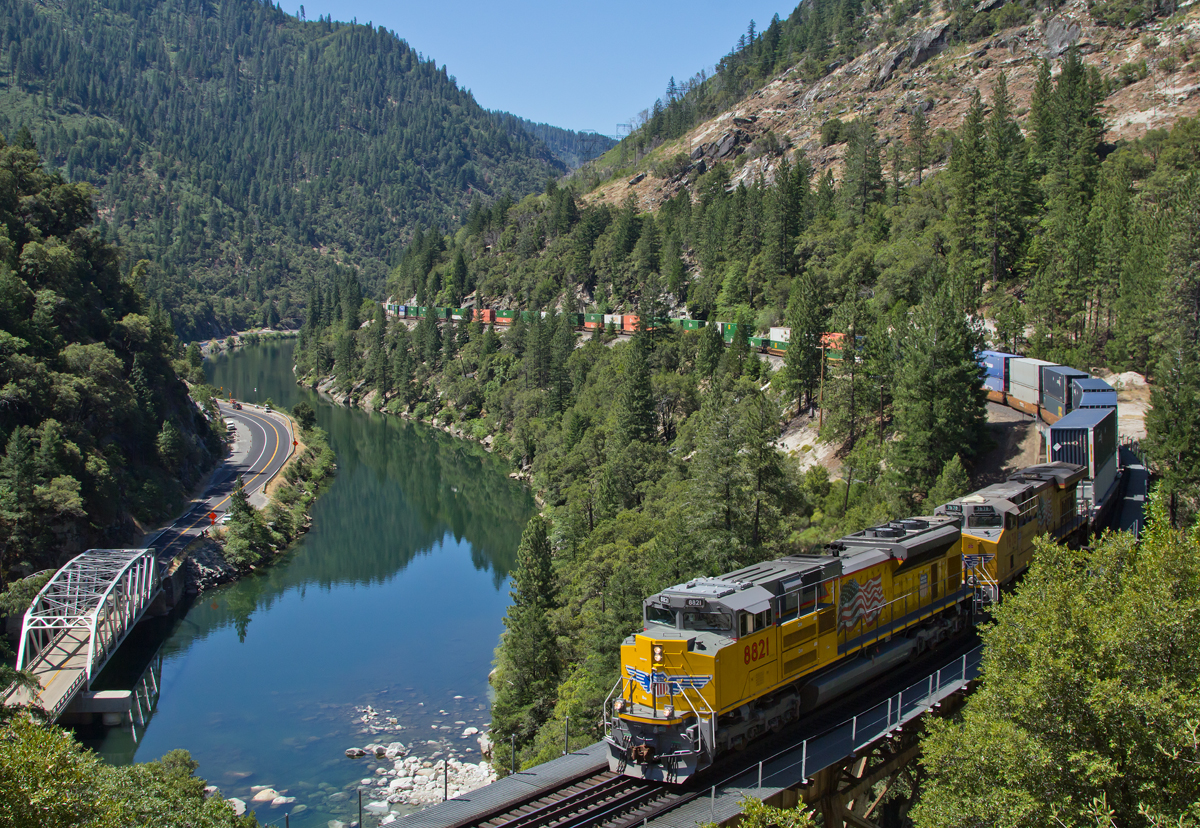
WASHINGTON — The Federal Railroad Administration issued a safety advisory today (Thursday, April 27) that encourages railroads to take steps to address the complexities of operating long trains.
The non-binding advisory — the second FRA has issued this month — comes in the wake of three recent derailments involving trains with more than 200 cars, a length of 12,250 feet or more, and a weight over 17,000 tons.
“Freight train length has increased in recent years, and while research is ongoing related to operational aspects of long trains, including brake system performance, it is known that the in-train forces longer trains experience are generally stronger and more complex than those in shorter train consists,” the FRA said. But the agency’s advisory did not recommend a cap on train length or tonnage.
The train length advisory, which builds on an April 6 train makeup advisory, makes eight recommendations that railroads should follow. They include:
-
- Review and update air brake and train handling rules to ensure they address the operation of long trains.
- Make changes to ensure that two-way end of train devices maintain communication with the head end.
- Adopt technology or procedures for maintaining radio voice communications between engineers and conductors.
- Identify changes to crew training, train handling procedures, train makeup, distributed power requirements, limitations on length or tonnage, speed restrictions, and inspection and maintenance requirements to ensure safe operation of longer trains.
- Review and update the locomotive engineer certification program to address operation of long trains.
- Review and evaluate existing operational testing data relevant to long trains.
- Take steps to minimize blocked grade crossings.
- Conduct post-accident simulations to assign primary and secondary factors for reportable accidents.
The use of long trains has come under scrutiny in recent years due to a combination of factors. Rail labor contends that long trains are inherently unsafe. Communities are reporting a rising number of blocked crossings. And elected officials have been critical of long trains after a string of high-profile derailments, including the Feb. 3 Norfolk Southern derailment in East Palestine, Ohio.
When issuing the train makeup advisory, safety officials said they had noticed a trend of train makeup problems contributing to six derailments of trains that had more than 125 cars.
The train length advisory cites three of those derailments — the March 4 Norfolk Southern derailment in Springfield, Ohio; the Nov. 1, 2022 NS derailment in Ravenna, Ohio; and the March 24, 2022 derailment of a Union Pacific train in Rockwell, Iowa — where train handling is believed to have caused or contributed to the wrecks.
The FRA noted that before certifying locomotive engineers, regulations require railroads to determine that an engineer “has demonstrated the skills necessary to safely operate trains in the most demanding class or type of service that the person will be permitted to perform. In the context of longer trains, the engineer must be adequately trained in their operation and demonstrate an ability to safely do so prior to being called for such operation.”
The safety advisory says it’s one thing to operate a 100-car train and quite another to operate one with 200 cars.
“An engineer who has safely operated a 100-car consist over a particular territory for the past five years, but has never been trained and qualified on a longer consist, should not be called to operate a 200-car train without additional training on the operational complexities involved,” the advisory says. “A locomotive engineer cannot be expected to safely operate in a more demanding service without proper additional training that covers the unique challenges and complexities those trains present.”
Rail labor leaders have long said that engineers need more training given the demands of operating long trains, including monitoring distributed power that may have locomotives placed in the middle and rear of trains.
Although the safety advisory lacks the teeth of regulations, industry observers expected railroads to follow the train length guidelines given the current focus on railroad safety in Washington and state legislatures. The Rail Safety Act proposed in the U.S. Senate would require the Department of Transportation to place a cap on train length and weight.
It was not immediately clear whether the 14-page advisory would lead to operational changes or curtailed train lengths.
The industry has maintained that long trains have operated safely for decades and that railroads’ safety records have improved significantly over the same period of time.
“All stakeholders – the FRA, railroads, and elected officials – share the same goal of continuously enhancing rail safety, minimizing adverse impacts to surrounding communities and keeping the goods that power our economy flowing,” an Association of American Railroads spokeswoman says. “The recommendations within this advisory align closely with the prudent steps railroads already take to do just that. The industry is committed to reviewing existing practices to see if there are areas for even greater safety improvement.”
Union Pacific noted that as train length has gone up, its mainline derailment rate has gone down.
“Union Pacific shares the same goals as our regulators, customers and the communities we serve – to safely deliver every carload. Even as train length has grown, mainline and siding derailments are down 13% since 2013 and 26% since 2019. We constantly evaluate our processes and continue to work with government agencies and industry partners to further improve safety,” spokesman Mike Jaixen says.
“Technology is playing a pivotal role in helping us continue to improve operational safety,” he adds. “One example is an advanced software tool that calculates a train’s forces in real time and allows a 24/7 expert operating team to monitor and make changes to train makeup or train handling instructions prior to departure. This technology-driven approach has further reduced mainline derailments throughout 2022 and thus far in 2023. Additionally, we are enhancing training programs and strengthening our safety culture through a joint effort with our union partners. We are also conducting root-cause analysis of incidents and engaging employees to help us identify action items to reduce the risk of injury or incident.”
The train makeup advisory was signed by the FRA’s top safety official, Karl Alexy. The train length advisory was signed by the FRA Administrator, Amit Bose.
“The advisory certainly goes beyond the earlier advisory’s focus on train make-up and that expanded scope may explain why the administrator wanted to be the signatory,” says Allan Rutter, who served as FRA administrator from 2001 through 2004. “How he and his safety team go about working with each of the Class I railroads to follow through on all the issues raised will be worth watching — implementing the advisory could have a bigger impact than issuing it.”
–Updated at 1:12 p.m. Central Time with AAR comment and at 5:22 Central Time with Union Pacific comment.














Vincent: Two of the railroads you mention the Rock and Milw should never have been built. They were in areas way over populated with other railroads plus the Milw line to the pacific coast already had to roads that competed with it.. The S.P. which served every nook and cranny of Calif lost its traffic to trucks and had to abandon hundreds of miles of branch lines with only seasonal traffic. Then like all other railroads lost local traffic on it main lines.
Otherwise, you hit the nail on the head.
Imagine if airlines could talk as casually about accidents as a train operator…., “yeah it fell out of the sky, but hey the number of crashes has gone down since the 90s so it’s obviously safe”
Trains should have 0 derailments a year. They are connected to the f’ing track! These people need to pull their heads out of their ass!
welcome to PSR railroading where service continues to get worse as trains get longer. trains should be limited to around a 100 cars. no amout of engineer training will make these longer trains safe. but we have to make wall street happy
These trains should already be banned as they interfere with the freight company’s obligations to give Amtrak priority. When these trains can’t safely use passing loops or double track sections because they are too long for them, they shouldn’t be on the publicly funded rail.
Publicly funded rail? Who are you trying to kid? Railroads fund the installation, repair and maintenance of their own systems. The only public money they receive may be in the form of grants to improve certain safety aspects or physical plant needs in the public interest of the railroads who apply for such grants which come no where near what the railroads themselves must spend to keep their track in decent shape. The Southern Pacific, the Rock Island the Milwaukee Road and the railroads which made up Conrail, were all doomed by their inability to turn enough profit to maintain their physical plant to run their own trains on. When purchased or merged with other railroads, enormous amounts of capital were required by the continuing corporations to bring these lines up to the required standards for safe operation. That expense was NOT publicly funded.
Amtrak on the other hand pays the national freight system little to nothing in the way of payments for use of the freight railroads lines but feel they should get top priority without regard for the customers of these lines. Meanwhile, trucks, planes and cars all run on the federally funded highway systems built and paid for by the taxes paid by American citizen and corporations, including the Railroads who must not only pay income tax, but also property tax for systems they have little use of.
I can see where you are coming from and PSR has made life for Amtrak much more difficult. But your assertion of the freight railroads using publicly funded rail is just plain wrong. While Amtrak is funded by the Congress of the United States, from taxes collected as stated above, the railroads of this country must pay for their own systems, at their own expense. They receive no subsidy unlike many foreign railroads who are subsidized by their own governments.
How many of these trains were being operated by trip optimizer?
Perhaps the government will build and profitably operate its own freight railroad?
It did a good job of it before.
Unfortunately Travis, we do not have the governments of the past which only ran the railroads in times of national crisis or war through institutions such as the United States Railroad Administration. (USRA) Our government of today doesn’t even fund Amtrak adequately.
I highly doubt the bureaucrats in our government, who can’t even agree on the national budget and growing deficit with obvious solutions stalled by lack of willpower to do the right thing, could ever manage the national rail network without bringing things to a grinding halt, with chaos in every corner. You think we have supply chain problems now, a government takeover of this countries rail freight system would cause problems of epic proportions which would last for decades, if at all.
I’m sure Rio Tinto and the othe Australian ore carriers are laughing at the FRA right now…200 cars, 12250 feet long or 17000 tons. Yeah, they do that in their sleep. I don’t care if it’s a single commodity hauled in a single type of rail car, those trains are still upwards of 300+ cars long, over 25000 feet and average 30000 tons. Sure it’s remote wilderness, but it’s still railroading with curves and grades and DPU’s.
Gerald, it may be 300+ cars but they are all loaded or empty,each car same weight. Big difference. Same route, excellent track
So Gerald, what is your point? Yes the Aussies do this in their sleep, as you say, but you can’t compare a railroad that runs in the bush with plenty of horsepower throughout the train, at controlled speeds with what is going on in this country where trains run through highly populated areas with all kinds of cargoes and rail car types of different ages. And the Aussies don’t have meets or carry hazardous cargoes, and when they are traveling, they are either all loaded, or all empty at uniform weights.
Show me an example where that exists in this country. The unit coal trains out of the Powder River Basin or other coal producing areas might come close but the topography they cover is totally different and even they do not run at the sizes you stated because they are relatively slow and get in the way of faster priority trains. And no other trains travel Rio Tinto’s mineral lines but those ore trains. And that is a huge difference.
If it’s not a rule it will be roundly ignored.
Operating long trains. What are the various configurations?
1. Long unit trains
a. Uphill
@ single
# various grades
$ curves or straight
b. downhill
@single grades
# various grades
c. level tracks
d. hog backs
@ intervals between peaks
2. Mixed unit trains
3. Intermodal
4. Long cars, short, or mixed
We could go on but combinations get into the hundreds.